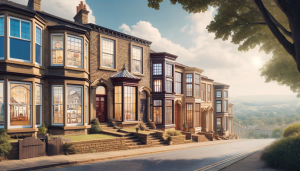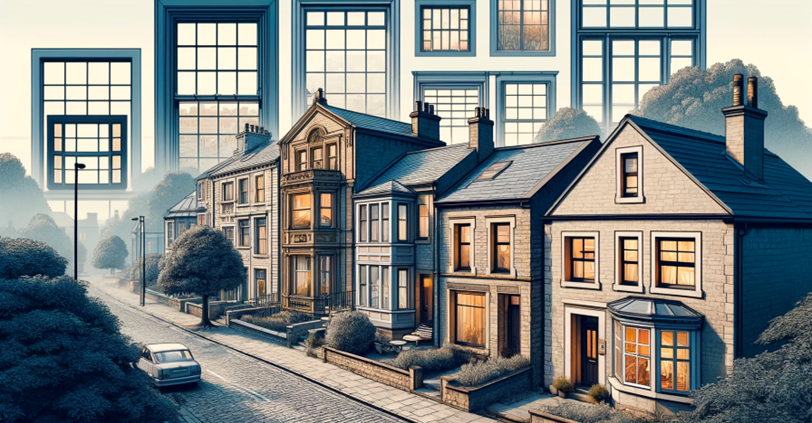Huddersfield Window Design
Exploring the Evolution of Window Design in Huddersfield: A Blend of Tradition and Modernity
Table of Contents
In Huddersfield, the distinctive blend of historical and modern architecture gives the town a unique aesthetic that is reflected vividly in its window designs. From charming Victorian terraces to cutting-edge contemporary structures, windows in Huddersfield do more than fill a functional need; they tell a story of time and taste. This blog explores the evolution of window design in Huddersfield, highlighting how each style not only complements the architectural integrity of its buildings but also enhances energy efficiency and personal comfort. Join us as we uncover the trends, technologies, and artistic expressions that shape the windows of Huddersfield, making each pane a portal to both the past and the future.

Historical Influence on Window Design
Victorian and Georgian Influences
Huddersfield’s architectural fabric is dotted with influences from various historical periods, particularly the Victorian and Georgian eras, which have significantly shaped the town’s window styles. The windows from these periods are renowned for their aesthetic craftsmanship and functionality. Sash windows, a staple in Victorian architecture, feature a classic design of movable panels that provide both ventilation and timeless elegance. Stained glass, often found in Georgian homes, not only enhances the beauty of the windows but also plays with light to add a colourful warmth to the interiors.
Transition to Modern Designs
As architectural trends have evolved, so too have the window designs in Huddersfield. Modern windows in newly constructed buildings or renovations now often feature minimalist frames and larger glass panes, maximising natural light and views. These contemporary styles contrast with, yet respect, the traditional designs, merging old charm with new efficiency.
Window Styles and Materials
Common Window Styles
Choosing the right style and material for windows can significantly impact a building’s appearance and energy efficiency. In Huddersfield, a variety of window styles and materials cater to different aesthetic preferences and practical requirements. In residential areas, casement windows are highly popular due to their versatility and ease of operation. Bay windows are another favourite, adding a spacious feel and panoramic views to any room. For modern practicality, tilt-and-turn windows offer excellent ventilation and cleaning convenience, making them a common choice for contemporary homes.
Material Selection
The choice of material for window frames significantly affects their performance and durability. Wood, revered for its natural look and insulating properties, remains a favourite for traditional designs. uPVC windows, on the other hand, offer a cost-effective, low-maintenance alternative that is particularly suited to the variable UK climate. Aluminium, with its robustness and slim profile, is increasingly chosen for modern constructions, providing a sleek, contemporary look without compromising on durability.
Energy Efficiency and Sustainability
Technological Advancements
In today’s world, energy efficiency is not just a bonus; it’s a necessity. Window designs in Huddersfield are increasingly focusing on features that not only enhance aesthetic appeal but also provide substantial energy savings and promote sustainability. Modern window technologies have revolutionised how windows contribute to a building’s energy efficiency. Double glazing is now standard in most new buildings, trapping air between two panes of glass to provide excellent thermal insulation. This technology minimises heat loss during the cold months and keeps interiors cool during the summer, significantly reducing heating and air conditioning costs.
Sustainability Practices
Sustainability is becoming a key consideration in window design, with an emphasis on materials that are both durable and eco-friendly. Many window manufacturers in Huddersfield are now using recycled materials for frames and incorporating energy-efficient features that align with green building standards. These practices not only help reduce the environmental impact but also cater to the growing demand for sustainable living solutions.
Customisation and Personalisation in Window Design
Bespoke Designs
The ability to customise window designs allows residents to tailor solutions that reflect their personal style while respecting Huddersfield’s architectural heritage. For those looking to maintain or restore the historical character of their properties, bespoke window designs are available. These custom designs are crafted to match the original aesthetics of older buildings, ensuring that upgrades do not detract from their historic value. Moreover, bespoke options allow for modern innovations like improved locking mechanisms or hidden ventilation systems that enhance functionality without compromising style.
Colour and Detailing
Today’s window frames are available in a wide range of colours and finishes. While traditional white remains popular, there is an increasing trend towards bold colours like black, grey, or even blue and green, offering a contemporary twist to window designs. Decorative details such as grids or leaded glass can also be added to enhance visual interest and complement the building’s overall design theme.
Future Trends in Window Design
Innovative Technologies
As we look to the future, window design is set to become even more innovative, integrating technology that offers greater control over comfort, security, and energy consumption. Smart windows are on the horizon in Huddersfield, featuring glass that can change its tint based on the sunlight’s intensity or even incorporate solar cells to generate electricity. These technologies not only promise to enhance the functionality of windows but also introduce new opportunities for energy generation and management in residential and commercial buildings.
Design Trends
The future of window design also leans towards even greater integration with a building’s aesthetic and functional needs. Seamless designs that blend almost invisibly with the walls, or windows that offer improved sound insulation in urban areas, are likely to become more prevalent. As technology and materials evolve, so too will the capabilities and roles of windows in architectural design. In conclusion, in Huddersfield, the design and functionality of windows are pivotal elements in the architectural identity of both historic and modern buildings. As we have seen, window styles and materials vary widely, offering bespoke solutions that cater to aesthetic preferences and practical needs. With a focus on energy efficiency and sustainability, window designs in Huddersfield are not only enhancing the visual appeal of buildings but also promoting greener living practices. As the town continues to grow and evolve, the trends in window technology and design are set to offer even more advanced solutions that promise to transform how light, air, and style interact within our spaces, making windows a key feature in the sustainable development of the area.





